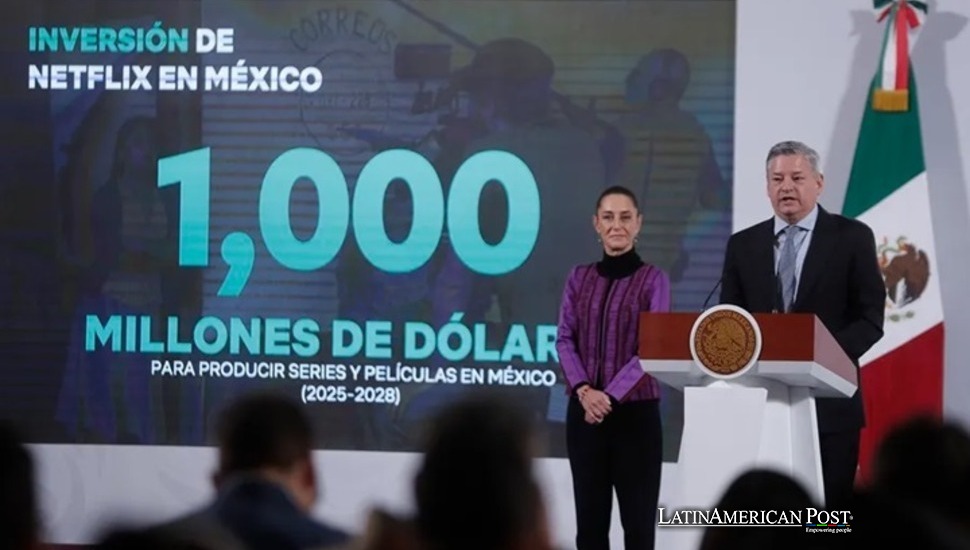Netflix Spurs Mexico Economy Triggering Billion-Dollar Surge

Netflix’s new plan to invest US$1 billion in Mexican film and TV production over four years is generating waves of excitement. With 20 upcoming series and films each year, the world’s top streaming service aims to transform local industries and the nation’s economy.
A Billion-Dollar Commitment to Mexican Growth
Netflix head Ted Sarandos said a US$1 billion investment plan at a press event with Mexican President Claudia Sheinbaum. This large move marks a turning point for Mexico’s audiovisual sector, which grew at home and abroad over the last decade. Netflix’s plan to produce 20 annual series and films in the country shows far more than casual interest—it suggests a deliberate move to harness Mexico’s evolving creative ecosystem.
The promised injection of funds will help the local entertainment market grow further, possibly surpassing the existing US$3 billion annual contribution that the broader audiovisual industry makes to Mexico’s gross domestic product (GDP). The new investment should further establish Mexico as one of Latin America’s preeminent production hubs, reflecting how streaming giants increasingly seek large, culturally rich markets for fresh stories and creative voices. With a population of more than 120 million people and a thriving cinema tradition, Mexico offers the perfect environment to produce telenovelas, feature films, documentaries, and other content that resonates worldwide.
Economic leaders in Mexico have lauded Netflix’s initiative. Netflix boosts cash flow immediately. It expands key sectors: local production companies, specialized equipment rentals, post-production studios, plus talent training programs. With Hollywood still contending with high costs and union negotiations, Mexico’s comparatively lower overhead and proven track record of cinematic innovation make the country particularly appealing. Netflix’s global brand, working together with Mexico’s creative businesses, could start a period of growth beyond movie productions covering tourism, merchandise, ads, etc.
President Sheinbaum mentioned Netflix’s “idea of a lively and thriving Mexico” to show that the government wants a strengthened partnership that may bring long-term economic benefits. She noted both the deal’s money value and the sign that large companies see Mexico as a secure, progressive place to invest. By framing the decision as a “privilege” for Mexico, Sheinbaum showcased the government’s pride in facilitating a project that has the potential to sustain thousands of jobs for years to come.
Collaboration with Mexico’s Creative Industry
Netflix’s relationship with Mexican talent dates back at least a decade, initiated by the streaming platform’s first-ever show outside the United States, Club de Cuervos, which premiered in 2015. At that time, Mexico was still exploring the possibilities of digital streaming, relying on a robust domestic broadcast television environment known for its telenovelas. Yet Club de Cuervos was a trailblazer, proving that Mexican narratives could transcend local audiences and resonate with global viewers.
The partnership reached new heights when Netflix produced and distributed Roma (2018), Alfonso Cuarón’s intimate, black-and-white masterpiece filmed in Mexico City. Acclaimed globally, Roma earned the Oscar for Best Foreign Language Film—making it the first Mexican entry and Netflix’s inaugural victory in that category. That triumph validated the streaming giant’s approach of pairing local authenticity with sophisticated production values. People saw that Mexico could produce movies that might win awards. Netflix then noted Mexico’s skilled film workers, from actors to camera operators and set makers, as a unique asset.
Netflix supports this local plan by working with many Mexican production houses, writers, directors. Instead of sending foreign teams, the company funds local projects, hires local talent. Sarandos said each new project is built with a local producer or a small local team. By sharing intellectual property rights and letting local storytellers guide narratives, Netflix hopes to capture the authenticity that resonates most with viewers both in Mexico and abroad.
Mexico’s government has reciprocated by streamlining paperwork and production procedures. Since the company opened its Latin America headquarters in Mexico City in 2020, local bureaucracy has become more accommodating to large-scale productions. The resulting synergy spurred the creation of approximately 300,000 jobs in Mexico’s audiovisual sector—both direct roles like production assistants, wardrobe managers, cinematographers and indirect ones in hospitality, transportation, and tourism. As Netflix launches its new wave of 20 annual projects, job numbers are expected to climb even more, which should feed into the national economy and bolster Mexico’s reputation as Latin America’s top entertainment hub.
Expanding Global Influence and Tourism
High-profile Netflix productions often reach millions worldwide, placing Mexico’s cities, rural backdrops, and cultural icons on an international stage. The phenomenon of “cinema-induced tourism” is already visible: iconic locations featured in previous Netflix hits or other major films see boosted visitor numbers, generating consumer spending. For instance, fans of Club de Cuervos frequently venture to the fictional city of Nuevo Toledo’s filming locations, contributing to local business revenue. Meanwhile, Roma put Mexico City’s Colonia Roma neighborhood on the global map, drawing film aficionados eager to see the real-life setting of Cuarón’s autobiographical drama.
With Netflix planning up to 20 new projects annually, the potential tourism surge could be even more dramatic. Productions might showcase coastal resorts, pre-Hispanic ruins, mountainous vistas, or the vibrant metropolises of Mexico City, Guadalajara, and Monterrey. Such exposure creates an authentic “living postcard,” enticing travelers to explore the actual locales they’ve admired onscreen. Restaurants, museums, shops, and hotels may gain more revenue, which will lift the overall tourism chain.
Mexico’s global brand could strengthen with these productions that focus on various cultural and historical matters. Netflix’s history shows a readiness to fund stories that explore local traditions, conflicts, or mythologies. The company has championed everything from lighthearted romantic comedies to gritty drama series tackling social issues. In each scenario, Mexico’s artistry gains new relevance for international audiences who consume these narratives—often discovering complexities that challenge stereotypes. By extension, the country’s “soft power” grows, opening doors for expanded cultural exchange, co-productions with other nations, and an elevated status in global entertainment circles.
Some experts note that increased inbound tourism can further galvanize local economies, stimulating real estate developments around filming hotspots or prompting improved infrastructure. When additional roads, better broadband connectivity, or upgraded airport facilities are needed to accommodate production demands, communities reap benefits that long outlast any given series or film shoot. Government officials, especially at state and municipal levels, see these expansions as catalysts to modernize neglected regions. For smaller towns far from tourism mainstays, a Netflix cameo could mark the start of a transformation in local employment, training, and services.
Sustained Economic Impact and Future Prospects
Given that the audiovisual sector already contributes around US$3 billion to Mexico’s GDP, Netflix’s new US$1 billion injection holds promise for a significant multiplier effect. The initial wave of direct spending—hiring creative professionals, securing film sets, and renting production equipment—could lead to a chain reaction of indirect revenue. Truck drivers, catering companies, costume suppliers, set builders, and local fixers will all see increased business. Restaurants, hotels, and shops near production areas can expect a steady stream of crew members, cast, and curious fans. Over time, a robust “production ecosystem” may solidify, setting the stage for Mexico to rival established filming hubs like Vancouver or certain parts of Europe in capturing a share of the global streaming production market.
President Sheinbaum stressed that these ventures go beyond mere show business. The intangible gains—international visibility for Mexican landscapes, the chance for local artists to shine, and the impetus for cross-cultural creative synergies—hold immense value. As she remarked, “It’s not just that the world sees Mexico in Netflix series. The real benefit is in the economic development and the colossal number of jobs generated.” Indeed, Sheinbaum’s administration worked to eliminate bureaucratic red tape, facilitating the logistic demands that large-scale productions require. This not only yields short-term improvements in efficiency but can also foster a regulatory environment conducive to future foreign investments outside of film—like tech startups, manufacturing expansions, or major infrastructure projects.
Industry analysts predict Netflix’s new annual output of 20 series and films could function as a launching pad for local stars, raising them to international celebrity status. The success of earlier examples—actors like Yalitza Aparicio in Roma or prominent directors such as Alfonso Cuarón—shows how a single Netflix film can rocket new faces onto the global stage. For Mexico’s creative people, from scriptwriters to animators, the latest productions offer roles plus ways to improve skills. Every new show gives the crew a chance to learn valuable lessons. Like any progress, problems may arise; local unions or guilds might push for higher wages, especially if Netflix’s success expands profit margins significantly. In addition, controversies regarding cultural appropriation or misrepresentation can arise if Netflix’s teams do not handle sensitive themes well. But so far, Netflix’s track record in Mexico indicates an inclination to partner with local experts and weigh cultural nuance. The entire enterprise is reminiscent of a careful dance: a global corporation invests heavily, but it must preserve authenticity and stay mindful of local sensibilities to maintain credibility.
Over the longer term, Netflix’s expansion in Mexico might spur healthy competition among streaming rivals. Amazon Prime Video, Disney+, and Apple TV+ could reinforce or escalate their local presence. Indeed, Latin America remains one of the world’s fastest-expanding streaming markets, with Spanish- and Portuguese-speaking nations generating substantial revenue growth. If Netflix sets a precedent for robust partnerships with local producers, other significant platforms may follow suit, fueling an arms race for the best studio facilities, on-location permits, and top creative minds. That contest, although intense, might boost Mexico’s role as a center of cultural production, ensuring steadier job prospects and technology transfers.
In the end, Netflix’s US$1 billion pledge shows a broader change in the global entertainment economy. As streaming becomes normal, content creation moves from one or two countries to many creative hubs around the world. Mexico’s proven ability to produce high-quality stories and singular aesthetics makes it a prime candidate for such a hub, just as Netflix recognized 10 years ago when it released Club de Cuervos. Now, with the re-election of the Sheinbaum administration and the unstoppable rise of streaming, the synergy seems to have reached its zenith.
Although much remains to be seen regarding how Mexico’s government will manage the sudden upsurge in production demands, officials appear optimistic. Netflix’s global brand, combined with Mexico’s local flair, can yield an enriched cultural environment for viewers around the world while simultaneously driving tangible economic benefits for Mexican communities. The path ahead is ripe with possibilities: new film sets might open in smaller Mexican towns, local film schools may experience surging enrollment, and tourism departments might coordinate with Netflix marketing to highlight filming locations. Through it all, the country’s economy will benefit by proving once more that Mexico is not only a tourist or manufacturing hub but also a key player in the global content scene.
Also Read: Latin America Builds Strategic Steel Defense Against China
In short, Netflix’s billion-dollar investment in Mexico boosts local entertainment, creates jobs, grows tourism, and unites cultures. While the final results remain to be evaluated over the next four years, the sense of anticipation is intense. Mexico’s creative industries are on the cusp of a new chapter—one shaped by massive streaming budgets, international acclaim, and the forging of a cultural identity that resonates far beyond its borders. The stakes are high, but so is the confidence that Mexico can stand at the forefront of the ever-evolving global media landscape.





